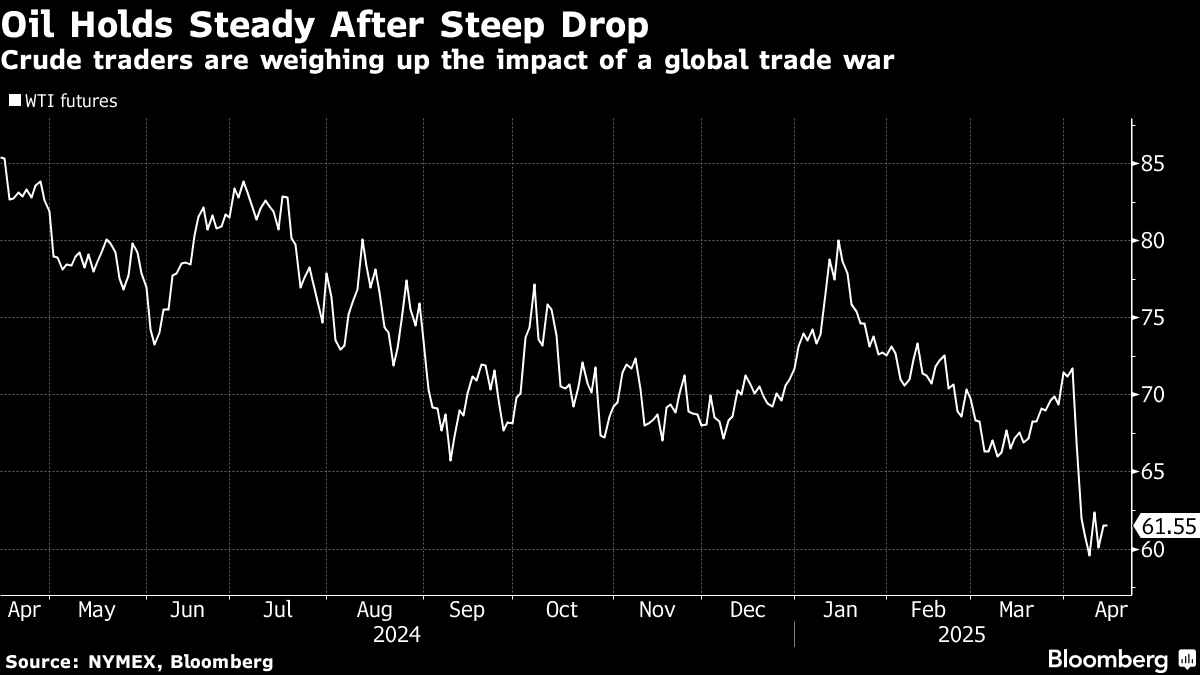Oil Steadies as Progress on Iran Talks Undercuts Tariff Reprieve
(Bloomberg) -- Oil held steady as traders weighed the latest US moves in the global trade war, as well as the prospect of looser restrictions on Iranian crude.
West Texas Intermediate settled little changed near $61.50 a barrel, and Brent held below $65. While equities rallied after US President Donald Trump paused import duties on some electronics, fresh data revealing that American consumers see higher inflation in the year ahead weighed on oil futures.
The US and Iran met on Saturday for nuclear talks that both sides described as constructive, raising the possibility of higher oil volumes from the OPEC member. Weekend talks in Oman marked the first top-level engagement since 2022 and signaled a renewed effort to resolve a years-long standoff over the country’s nuclear program. Both sides agreed to meet again.

On the demand side, traders are grappling with a rapidly evolving outlook. The Organization of the Petroleum Exporting Countries slashed its projections for annual consumption growth by about 100,000 barrels a day, following a larger cut by the US Energy Information Administration. More banks also reduced their price forecasts, with JPMorgan Chase & Co. now seeing Brent at $66 this year.
Crude has been dragged down in April as the trade war — especially the confrontation between the US and China — stokes fears of a global recession that would hurt energy demand. A surprise OPEC+ decision to bring back shuttered output more quickly than expected has added to the bearishness.
“While the market has already priced in some future inventory builds, we expect large surpluses,” Goldman Sachs Group Inc. analysts including Daan Struyven said in a note, estimating a glut of 800,000 barrels a day this year. Brent is expected to average $63 over the rest of 2025, they said.
Oil’s losses this month have formed part of an intense global market reaction to the evolving trade war, with most commodities and equities selling off. Investors pulling out of crude and fuel markets triggered a $2 billion net outflow in the week ending April 11, JPMorgan Chase & Co. analyst Tracey Allen wrote in a note to clients.
There have also been unusual declines in the US dollar and Treasuries, assets that typically function as havens during periods of stress.
©2025 Bloomberg L.P.
KEEPING THE ENERGY INDUSTRY CONNECTED
Subscribe to our newsletter and get the best of Energy Connects directly to your inbox each week.
By subscribing, you agree to the processing of your personal data by dmg events as described in the Privacy Policy.
More oil news

Oil Edges Higher With Focus on Tariff Moves, US-Iran Discussions

Goldman Sachs Warns Oil Faces ‘Large Surpluses’ Through 2026

Chevron Ordered to U-Turn Venezuela Oil Ahead of Sanctions

Shale Drillers Idle US Rigs at Fastest Pace in Almost Two Years

Oil Heads for Weekly Decline as Trade War Roils Global Markets

US Crude Flows to China Trickle to Near Zero After Tariff Blitz

Aramco announces discovery of 14 new oil and gas fields in Eastern Region

Oil Extends Steep Selloff as Fresh Tariff Wave Imperils Demand

Oil Edges Higher After Three-Day Tumble With Trade War in Focus
















